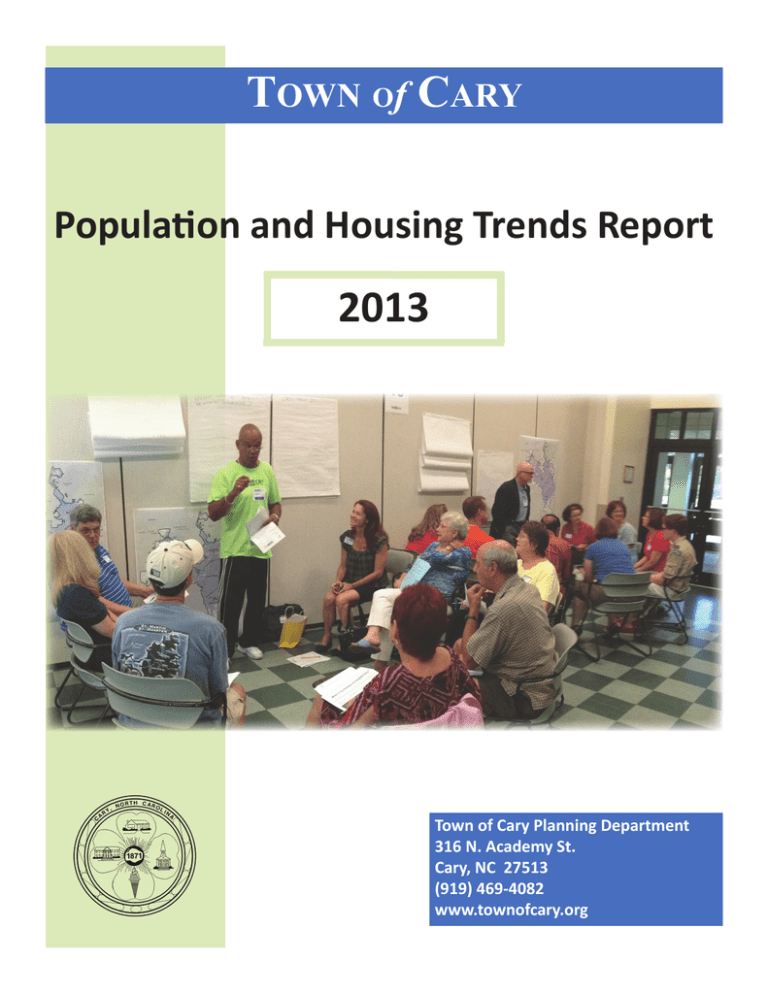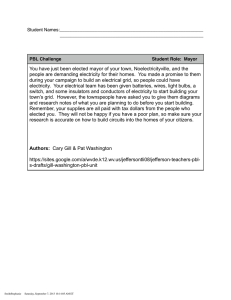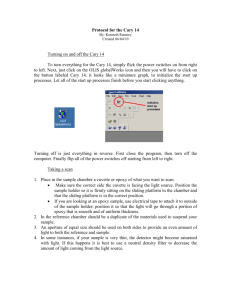Population and Housing Trends Report
advertisement

Town of Cary Population and Housing Trends Report 2013 Town of Cary Planning Department 316 N. Academy St. Cary, NC 27513 (919) 469-4082 www.townofcary.org Town of Cary Population and Housing Trends Report Introduction Executive Summary This population report is prepared annually by the Town of Cary Planning Department to provide greater detail on vital statistics, including: historical and current population data, population forecasts, demographics, and income characteristics. This year’s report contains the newest population and housing data available from the 2000 decennial census, the 2011 American Community Survey data and an annual population count performed by the Town of Cary. Quick Facts Year Incorporated: 1871 Population: 144,316 Land Area: 56.31 Square Miles Contents Demographics..........2 Population ................4 Land Growth .............6 Housing ....................7 Cost of Living............10 Employment/Jobs...11 2 Town of Cary Population and Housing Trends Report - 2013 Demographic Profile 2000 2011 Demographics 2000 Social Characteristics Sex & Age Educational Attainment Total Population 94,563 138,296 Male 50.2% 49.3% High School Graduate (or equivalent) Female 49.8% 50.7% 33.7 37.7 29.1% 26.4% 5.4% 10.1% Median Age % Population 18 years and under % Population 65 years and over Households Total Housing Units 36,863 41,930 Average Household Size 2.69 2.85 Average Family Size 3.18 3.48 Race Total Population 2011 Population 25 years and over 61,114 92,909 10.7% 15.7% Associate Degree 7.3% 8.1% Bachelor’s Degree 37.7% 33.2% Graduate or Professional Degree 23.0% 23.9% High School Graduate or higher 95.1% 93.4% Percent bachelor’s degree 60.7% 57.1% 94,563 138,926 Native (U.S.) 86% 77% Foreign Born 14% 23% 36,863 51,930 94.7% 93.7% Place of Birth Total Population Housing Characteristics 94,563 138,296 One Race 98.2% 99.1% White 82.2% 71.2% Black or African American 6.1% 7.5% Owner-occupied 72.8% 70.4% American Indian & Alaska Native 3.0% 0.7% Renter-occupied 27.2% 29.6% Asian 8.1% 14.6% 5.3% 6.3% Some other race 1.8% 6.0% Avg Household Size - Owner-occupied N/A 3.06 Avg Household Size - Renter-occupied N/A 2.36 Median Home Value - Owner-occupied $196,700 $314,400 Economic Characteristics Employment Population 16 years and over 69,653 107,176 In labor force 76.3% 69.3% 76.1% 69.3% 74.2% 64.9% 2.0% 4.4% Civilian labor force Employed Unemployed Armed Forces 0.2% 0.0% 23.7% 30.7% 51,175 68,706 22.9 22.5 Median Household Income $75,122 $82,509 Median Family Income $88,074 $110,329 Per Capita Income Not in labor force Commuting to Work Workers 16 years and over Mean Travel Time to Work (minutes) Income $32,974 $36,900 % Families below poverty level 2.1% 3.2% % Individuals below poverty level 3.4% 5.6% Source: US Census Bureau, 2011 American Community Survey Total Housing Units Occupied Housing Units Vacant Housing Units Median Monthly Mortgage Median Monthly Gross Rent $1,493 $1,853 $826 $884 Town of Cary Population and Housing Trends Report - 2013 Demographic Snapshot The 65+ years age group has increased its share of the Town’s population from 5.4 percent in 2000 to 10 percent in 2011. The median age of Town residents has increased by 4 years since 2000 and is consistent with state and national averages. The Town’s population continues to lead state and national averages in level of educational attainment. Nearly half of Cary’s residents have a Bachelor’s degree or higher. The average household size in Cary has slightly declined from 2000 to 2011 but is still above state and national averages. The Town’s Hispanic population has grown in share of total population from 2000 to 2011 but it is still below state and national levels. The Town’s Asian population is the fastest growing population in Cary and is well above state and national levels. Source: US Census Bureau, 2011 American Community Survey 3 4 Town of Cary Population and Housing Trends Report - 2013 Population 144,316 Official Town of Cary population estimate as of April 1, 2013 Year Population - Fiscal Year Population Annual Growth Rate 1980 21,958 4.8% 2000 95,949 8.6% 2001 99,798 4.0% 2002 103,260 3.5% 2003 106,715 3.3% 2004 108,152 1.3% 2005 111,039 2.7% 2006 115,854 4.3% 2007 122,643 5.9% 2008 127,201 3.7% 2009 131,862 3.7% 2010 136,690 3.7% 2011 139,382 2.0% 2012 142,257 2.1% 2013 144,982 1.9% Figures in bold text are official US Census counts. Other figures are Town of Cary estimates. 5 Town of Cary Population and Housing Trends Report - 2013 Historical Population Decennial Census Year Population Percent Change 1940 1950 1960 1970 1980 1990 2000 2010 1,141 1,496 3,356 7,640 21,763 43,858 94,536 135,264 31.1% 124.3% 127.7% 184.9% 101.5% 115.6% 43.1% Source: US Census Bureau The Town of Cary’s population has grown 53 percent from 2000 to 2013. According to Census figures, Cary’s population doubled every ten years from 1960 to 2000, growing by more than 90,000 people during that 40-year period. Cary is the seventh largest city in North Carolina. The Town of Cary’s population in 1900 was 333. Town of Cary Population and Housing Trends Report - 2013 Land Growth Source: Town of Cary Planning Department 6 Town of Cary Population and Housing Trends Report - 2013 7 Housing Source: US Census Bureau, 2011 American Community Survey The average home sales price in the Town of Cary was $285,000 in 2012. Single family homes represented 75.1% of total home sales in 2012. The number of multi-family housing units has grown from 2000 to 2012 from 24% of the Town’s total housing stock to 28%. The majority of these units are apartments. Cary Residential Sales by Price Range and Type of Unit - Calendar Year 2012 Price Range Single Family Townhouse Condo All Units % of Total Units $25,000-$100,000 3 15 26 44 1.9% $100,001-$150,000 46 88 13 147 6.5% $150,001-$200,000 205 146 13 364 16.1% $200,001-$250,000 189 191 4 384 17.0% $250,001-$300,000 245 42 4 291 12.9% $300,000-$350,000 294 11 0 305 13.5% $350,001-$400,000 199 0 0 199 8.8% over $400,000 515 9 0 524 23.2% Total Units 1,696 502 60 2,258 % of Total Units 75.1% 22.2% 2.7% $395,000 $213,750 N/A $332,225 Average Sales Price (New) Average Sales Price $288,500 $172,500 $108,500 $255,000 Average Sales Price $325,000 $205,000 $108,500 $285,000 (Resale) (New & Resale) Source: Wake County Revenue Department 8 Town of Cary Population and Housing Trends Report - 2013 Housing Town of Cary Income Trends Year 2000 1990 Median Household Income (2011 Dollars) Percentage Change Rent Trends Rent (2011 Dollars) Percentage Change Mortgage Trends Median Mortgage (2011 Dollars) Percentage Change House Value Trends Median House Value (2011 Dollars) Percentage Change Source: US Census Bureau, 2011 American Community Survey $79,612 2011 $98,129 $82,509 + 23.3% - 15.9% $771 $1,079 + 39.9% $884 - 18.1% $1,700 $1,951 + 14.8% $1,853 - 5.0% $187,254 $256,942 + 37.2% $314,400 + 22.4% 9 Town of Cary Population and Housing Trends Report - 2013 Housing More than 90 percent of the Town’s housing stock was built in the last three decades. More units were built in the 1990’s than any other decade. Almost 30 percent of people who have moved to Cary from 2010 to 2011 came from outside of Wake County. Source: US Census Bureau, 2011 American Community Survey 10 Town of Cary Population and Housing Trends Report - 2013 Cost of Living ACCRA Cost of Living Index - 2012 100% Metro Urban Grocery Composite Area Items Index Asheville, NC 101.2 105.3 Charlotte-Gas94.7 103.2 tonia-Concord, NC/SC Durham, NC 92.7 99.6 Fayetteville, NC 96.1 107.5 Greenville, NC 95.5 108.2 Raleigh-Cary, NC 90.9 101.0 Wilmington, NC 99.1 107.7 Winston-Salem, 88.5 100.4 NC 96.0 81.3 103.1 100.1 101.3 96.9 107.8 97.4 Misc. Goods & Services 102.4 99.4 79.0 80.6 78.6 71.5 84.4 71.0 90.1 101.8 96.7 104.8 112.2 93.2 100.2 93.6 96.0 95.9 100.3 85.6 98.0 101.5 113.4 93.6 96.0 103.0 98.5 102.8 101.1 95.7 103.6 95.8 Housing ACCRA The American Chamber of Commerce Researcher’s Association (ACCRA) collects data from participating Metro-Micro Urban Areas across the United States to publish quarterly reports on cost of living information for these areas. These reports can be used to compare the relative price levels for consumer goods and services of one Metro-Micro Urban Area to another. The average for all of these areas equals 100, and each participant’s index is read as a percentage of the average for all places. So an index score above 100 indicates that the particular area spends more than the average U.S. Metro-Micro area on that particular good or service. The index does not measure for inflation so index data from different quarters should not be compared. Raleigh-Cary Metro For 2012, the Raleigh-Cary, NC Metro had a composite index of 90.9, one of the lowest of the Source: ACCRA, 2012 Utilities TransportaHealth Care tion NC Metro areas. This represented a large change from 2009 when the composite index was 101.5, the second highest among the NC Metro areas. The Housing cost of living index was a big part of this drop, falling from 90.2 in 2009 to 71.5 in 2012, one of the lowest in the state. Town of Cary Population and Housing Trends Report - 2013 11 Employment/Jobs Source: US Census Bureau, American Community Survey The percentage of Cary residents in the labor force has seen a decrease of 7.3% since 2000. As a whole, a significantly higher portion of the Town’s working age population participate in the labor force, compared with the state and nation. Source: Wake County Economic Development Top Ten Employers 1 SAS Institute, Inc. 2 Verizon Wireless 3 WakeMed Cary Hospital 4 Town of Cary 5 American Airlines 6 Wake County Public School System 7 Kellogg’s Snacks 8 Siemens Medical Solutions USA 9 John Deere Co. 10 LORD Corporation Town of Cary Population and Housing Trends Report - 2013 12 Employment/Jobs Cary Accolades • #3 Best Mid-Sized City To Move To (Cary, NC) Movoto | December 2013 • #2 City Creating the Most Technology Jobs (Raleigh-Cary, NC) Forbes | November 2013 • #2 Best City for Early Retirement (Cary, NC) Kiplinger’s Personal Finance | October 2013 • #7 City for High-Paying Jobs (Raleigh-Cary, NC) Payscale.com | October 2013 • #6 Best Metro for Recent College Graduates (Raleigh-Cary, NC) The Atlantic Cities | September 2013 • #8 Small American City of the Future 2013/14 – Economic Potential (Cary, NC) fDi Intelligence | April 2013 • #3 American Boomtown (Raleigh-Cary, NC) Bloomberg | April 2013 Occupations of Employed Civilians - Cary - 2011 Occupation Management & Professional Sales Service Production & Transportation Construction, Extraction, Maintenance & Repair Farming, Fishing & Forestry Source: US Census Bureau, 2011 American Community Survey Percent of Employed Civilians 52.9% 24.0% 13.5% 5.5% 3.7% 0.4%




